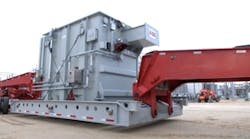A new type of utility-grade transformer could replace units damaged by storms or disasters in days instead of weeks or months. Known as a “recovery transformer” or RecX, the first prototype is now sitting at a substation near Houston for testing. The transformer is the product of a consortium consisting of the Dept. of Homeland Security (DHS) Science and Technology Directorate, transformer manufacturer ABB Inc., utility CenterPoint Energy Inc., and the Electric Power Research Institute (EPRI).
The goal of the RecX program is to make the electric transmission grid more resilient by getting up and running quickly after extra high voltage (EHV) transformer outages. Approximately 80,000 miles of EHV transmission lines stretch across the U.S. EHV transformers are critical components for transmission, with more than 90% of all power flowing through the grid and EHV transformers on its way to consumers.
EHV transformers are the grid components most susceptible to a sustained outage and are often located in remote substations. These units weigh hundreds of tons and are too large to easily transport by road, requiring customized railcars instead. Replacing a damaged EHV transformer can take up to two years if a new one must be built from scratch. In some cases, spares are available, but can take several months to move, put in place, and energize.
The need for easily deployable recovery transformers was first identified by the utility industry after 9/11 as part of the EPRI infrastructure security initiative. In 2008, DHS partnered with the industry to sponsor RecX and is managing the project with EPRI as the principal contractor.
The RecX prototype is designed to replace the most common EHV transformer in the utility fleet, a 345/138 kV autotransformer. The design is based on conventional transformer technologies, but with an emphasis on modularity, easy transport, and fast installation. The principal design challenge involved significantly reducing weight and size while maintaining performance and reliability. Rather than a traditional three-phase design in a single unit, the RecX prototype consists of three separate single-phase units at 345/138 kV, 200 MV-A/phase.
A pilot demonstration held in March simulated an emergency scenario to fully test the new transformer and its deployment concept. RecX units and supporting equipment were transported by road in a series of convoys, from the ABB factory in St. Louis to the CenterPoint substation near Houston where utility crews worked around the clock to install, assemble, and energize the prototype. In the drill, workers reduced standard recovery time by 75%. RecX will remain operational in the grid for at least one year so engineers can observe, monitor, and validate its performance. Units are built to last as long as traditional three-phase EHV transformers, which have a life of about 30 to 40 years. If used as a spare in an emergency, RecX units could either remain in place or go back into storage once a traditional three-phase unit is available.
“The successful completion of this drill represents a quantum leap for the electric industry to rapidly replace EHV transformers in emergency situations,” says Rich Lordan, an EPRI technical executive and recovery transformer project manager. “This demonstrates a way forward for the industry to dramatically reduce restoration time in the event of simultaneous failure of multiple transformers. After about a week without power, the fabric of society really begins to unravel. The RecX project addresses this issue in the case of a catastrophic power outage.”
According to EPRI’s analysis, the RecX design is a suitable replacement for more than 90% of the transformers in its voltage class. Spares could reside at secure regional locations, designed to the specific voltage levels used in each region, and rapidly deploy as needed.
Resources
EPRI, www.epri.com
